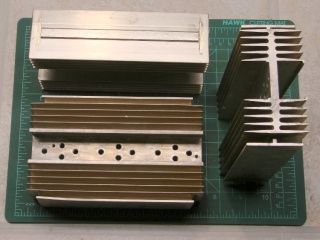Some diligent rummaging turned up a trio of heatsinks that I think will work nicely for the Hot Box Disinsector. As nearly as I can tell from the date codes, they started life at IBM in the early 70s and are built to take a direct hit; the bent fins show they’ve taken a few shots along the way. Those clips applied direct clamping pressure to the transistor cases: much better than screws that can will eventually deform the aluminum and stop forcing the case against the heatsink.

To judge from the crud built up on the fins and the fact that some of the transistors are now completely open, these puppies were run hard and put up wet.
I wiped off the heatsink grease, cleaned off the bigger chunks of crud, and popped them in the dishwasher for a good scrubbing.

Lovely! The web across the middle is 1/4-inch thick; they don’t make ’em like that any more. The rear heatsink lost its mounting flanges along the way; I have no idea if I sawed those off or somebody else got there first.
I’ll probably plug the holes, just because it’s a nice idea; the sinks are certainly overqualified for their next job as they stand. TO-3 transistors have power ratings over 100 W: these are at least 300 W heatsinks, albeit with an unknown operating temperature. Egad & similar remarks.
In round numbers, I need maybe 150 W of heat at 140 °F ambient. Each heatsink will dissipate 50 W, which is certainly well under its original rating. Figuring 0.5 °C/W sink-to-ambient (call it 1 °F/W) with decent air flow, dissipating 50 W will raise the heatsinks to 190 °F.
That’s higher than I want, so more doodling & measurements are in order.

I got some used heatsinks from the “Theta Pinch” experiment at the University of Maryland that were pretty serious. These were liquid cooled (aluminum bent to grip copper cooling pipes) and seriously thick. And something had gone seriously wrong at some point – there were holes melted through the heatsink under several of the transistors. Egad indeed!
holes melted through the heatsink
… and the transistors just weren’t any good after that …